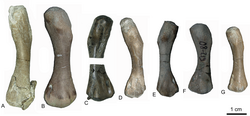Anarosaurus is an extinct genus of pachypleurosaurs that lived in the Middle Triassic period (Anisian) and has been found in the Jena Formation and the Karlstadt Formation of Germany and the Winterswijk Quarry (Lower Muschelkalk) of The Netherlands.[1] Two species are known: A. pumilio (the type species)[2] and A. heterodontus.[3] The holotype of A. pumilio was originally housed at the Institut und Museum fur Geologie und Palaontologie, Georg-August-Universitat, Gottingen, but can no longer be located today because it was lost or destroyed during World War II.[4] Anarosaurus was a small reptile with an estimated body length of 50–60 cm (1.6–2.0 ft).[5]
| Anarosaurus Temporal range: Anisian,
| |
|---|---|

| |
| Anarosaurus heterodontus humeri | |
| Scientific classification | |
| Domain: | Eukaryota |
| Kingdom: | Animalia |
| Phylum: | Chordata |
| Class: | Reptilia |
| Superorder: | †Sauropterygia |
| Family: | †Pachypleurosauridae |
| Genus: | †Anarosaurus Dames, 1890 |
| Species | |
See also
editReferences
edit- ^ Klein, N. (2009). "Skull morphology of Anarosaurus heterodontus (Reptilia: Sauropterygia: Pachypleurosauria) from the Lower Muschelkalk of the Germanic Basin (Winterswijk, the Netherlands)". Journal of Vertebrate Paleontology. 29 (3): 665–676. Bibcode:2009JVPal..29..665K. doi:10.1671/039.029.0327. S2CID 86204928.
- ^ Dames, W. (1890) Anarosaurus pumilio nov. gen. nov. sp. Zeitschrift der Deutschen Geologischen Gesellschaft 42:74-85.
- ^ O. Rieppel and K. Lin. (1995) Pachypleurosaurs (Reptilia: Sauropterygia) from the Lower Muschelkalk, and a review of the Pachypleurosauroidea. Fieldiana: Geology, new series (32)1-44
- ^ Kuhn O. (1971), Die Saurier der deutschen Trias [Reptiles of the German Triassic], 1-105
- ^ Houssaye, A. (2013). "Bone histology of aquatic reptiles: what does it tell us about secondary adaptation to an aquatic life?". Biological Journal of the Linnean Society. 108 (1): 3–21. doi:10.1111/j.1095-8312.2012.02002.x. S2CID 82741198.